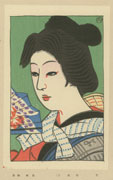Prints in Collection
Yoshichō no Nanako, 1915
IHL Cat. #220
Biographical Data
Biography
Ishizuka Kan 石塚翰 (active c. 1915)Ishizuka Kan contributed two prints of kabuki actors to Shin Nigao Magazine. He was a member of Sango-kai (Coral Society) as detailed below.
http://www.tobunken.go.jp/~bijutsu/publications/bijutukenkyu/376_Sangokai.html
COMPILATION OF MATERIALS RELATED TO THE SANGO-KAI
Sango-kai (Coral Society)
Sources: Independent Administrative Institution National Research Institute for Cultural Properties, Tokyohttp://www.tobunken.go.jp/~bijutsu/publications/bijutukenkyu/376_Sangokai.html
COMPILATION OF MATERIALS RELATED TO THE SANGO-KAI
by Kikuya, Yoshio and Shioya, Jun
The Sango-kai was a small artists group centered on the activities of Nihonga painters. In Taisho 4 (1915) the group was formed by eight painters: Hirafuku Hyakusui as the main member, joined by Ikeda Eiji (1889-1950), Ogawa Usen (1868-1938), Ogawa Senyou (1882-1971), Kawabata Ryushi (1885-1966), Tsuruta Goro (1890-1969), Natori Shunsen (1886-1960) and Yamamura Toyonari [also Koka or Kouka (1885-1942)]. This group was active until its 10th exhibition held in Taisho 13 (1924). Morita Tsunetomo (1881-1933), Kondo Koichiro (1884-1962), and Ishizuka Kan joined the initial members midway through the group's history, and at the end of the group's activities, Sakai Sanryo (1897 - 1969) and Okamoto Ippei exhibited works in the group's exhibitions. While technically exhibiting Nihonga works, Ogawa Usen and Kawabata Ryushi had both been trained in Western-style painting, and Tsuruta Goro was an active Western-style painter, while Okamota Ippei and Ikeda Eiji were both manga artists. Thus the group was not necessarily a unified front, but rather a place where they could share interests and studies on an equal footing as individual friends and colleagues. It seems to have been a place for extremely free exchange.
The Sango-kai was a small artists group centered on the activities of Nihonga painters. In Taisho 4 (1915) the group was formed by eight painters: Hirafuku Hyakusui as the main member, joined by Ikeda Eiji (1889-1950), Ogawa Usen (1868-1938), Ogawa Senyou (1882-1971), Kawabata Ryushi (1885-1966), Tsuruta Goro (1890-1969), Natori Shunsen (1886-1960) and Yamamura Toyonari [also Koka or Kouka (1885-1942)]. This group was active until its 10th exhibition held in Taisho 13 (1924). Morita Tsunetomo (1881-1933), Kondo Koichiro (1884-1962), and Ishizuka Kan joined the initial members midway through the group's history, and at the end of the group's activities, Sakai Sanryo (1897 - 1969) and Okamoto Ippei exhibited works in the group's exhibitions. While technically exhibiting Nihonga works, Ogawa Usen and Kawabata Ryushi had both been trained in Western-style painting, and Tsuruta Goro was an active Western-style painter, while Okamota Ippei and Ikeda Eiji were both manga artists. Thus the group was not necessarily a unified front, but rather a place where they could share interests and studies on an equal footing as individual friends and colleagues. It seems to have been a place for extremely free exchange.
